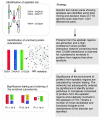Integrative analysis for finding genes and networks involved in diabetes and other complex diseases
- PMID: 18045462
- PMCID: PMC2258178
- DOI: 10.1186/gb-2007-8-11-r253
Integrative analysis for finding genes and networks involved in diabetes and other complex diseases
Abstract
We have developed an integrative analysis method combining genetic interactions, identified using type 1 diabetes genome scan data, and a high-confidence human protein interaction network. Resulting networks were ranked by the significance of the enrichment of proteins from interacting regions. We identified a number of new protein network modules and novel candidate genes/proteins for type 1 diabetes. We propose this type of integrative analysis as a general method for the elucidation of genes and networks involved in diabetes and other complex diseases.
Figures



Similar articles
-
The type 1 diabetes - HLA susceptibility interactome--identification of HLA genotype-specific disease genes for type 1 diabetes.PLoS One. 2010 Mar 5;5(3):e9576. doi: 10.1371/journal.pone.0009576. PLoS One. 2010. PMID: 20221424 Free PMC article.
-
Epistasis effect: an alternative to the hypothesis of linkage disequilibrium in HLA associated diseases.Ann Hum Genet. 1980 Oct;44(2):195-204. doi: 10.1111/j.1469-1809.1980.tb00958.x. Ann Hum Genet. 1980. PMID: 7316470 No abstract available.
-
Functional relevance for type 1 diabetes mellitus-associated genetic variants by using integrative analyses.Hum Immunol. 2015 Oct;76(10):753-8. doi: 10.1016/j.humimm.2015.09.033. Epub 2015 Sep 30. Hum Immunol. 2015. PMID: 26429317
-
The HLA system and the analysis of multifactorial genetic disease.Trends Genet. 1995 Dec;11(12):493-8. doi: 10.1016/s0168-9525(00)89159-3. Trends Genet. 1995. PMID: 8533166 Review.
-
HLA complex genes in type 1 diabetes and other autoimmune diseases. Which genes are involved?Trends Genet. 2001 Feb;17(2):93-100. doi: 10.1016/s0168-9525(00)02180-6. Trends Genet. 2001. PMID: 11173119 Review.
Cited by
-
Structure and dynamics of molecular networks: a novel paradigm of drug discovery: a comprehensive review.Pharmacol Ther. 2013 Jun;138(3):333-408. doi: 10.1016/j.pharmthera.2013.01.016. Epub 2013 Feb 4. Pharmacol Ther. 2013. PMID: 23384594 Free PMC article. Review.
-
Analysis of AML genes in dysregulated molecular networks.BMC Bioinformatics. 2009 Sep 17;10 Suppl 9(Suppl 9):S2. doi: 10.1186/1471-2105-10-S9-S2. BMC Bioinformatics. 2009. PMID: 19761572 Free PMC article.
-
Analysis of AML Genes in Dysregulated Molecular Networks.Summit Transl Bioinform. 2009 Mar 1;2009:1-18. Summit Transl Bioinform. 2009. PMID: 21347161 Free PMC article.
-
Identification of T1D susceptibility genes within the MHC region by combining protein interaction networks and SNP genotyping data.Diabetes Obes Metab. 2009 Feb;11 Suppl 1(Suppl 1):60-6. doi: 10.1111/j.1463-1326.2008.01004.x. Diabetes Obes Metab. 2009. PMID: 19143816 Free PMC article.
-
The molecular pathogenesis of HIV-1 associated nephropathy: recent advances.J Mol Med (Berl). 2011 May;89(5):429-36. doi: 10.1007/s00109-010-0719-x. Epub 2011 Jan 11. J Mol Med (Berl). 2011. PMID: 21221512 Review.
References
-
- The Gene Ontology http://www.geneontology.org
Publication types
MeSH terms
Substances
Grants and funding
LinkOut - more resources
Full Text Sources
Medical

